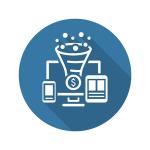We all know that what goes up must come down—which is fine when you’re talking about the law of gravity, but more painful when you’re talking about sales performance.
As David Taber explains, though, CRM becomes particularly valuable for a company in helping pinpoint some of the potential holes in a given company’s sales methodology, especially if they know a bit about what to look for. In a recent article on CIO.com, the consultant and author of Salesforce Secrets of Success outlines seven different areas to monitor within CRM to improve results. These two were particularly notable: deal velocity and deal regression.
“What you want to do is compare how many days deals spend in each stage of the pipeline, looking for differences between the winners, the losers, and the open deals,” Taber writes in reference to deal velocity. “You’re likely to find that winners go faster than losers, and you should be able to identify at which stage a deal is most likely to die.”
Deal regression, on the other hand, refers to the percentage of deals that move out in time, backwards in stage, or down in value. “If this is over a few per cent, it’s an indication of ‘bogusity’ in the pipeline,” Taber says.
Your Pipeline, Deconstructed
One way to start shifting the balance between deal velocity and deal regression was outlined in a book published earlier this year called Hacking Sales: The Playbook For Building A High-Velocity Sales Team. The author, Max Altschuler, suggests small and medium-sized companies start by breaking down the core components of their pipeline in order to conduct the right kind of analysis. A sample of these areas would include the following:
- Total number of deals in the pipeline
- Average deal size
- Per cent of deals that move from one stage to another until close
“You’ll want to find baseline numbers to measure each stage of the sales process,” Altschuler writes. “Be extremely diligent about staying on top of these numbers as they move from stage to stage. Using a good CRM tool could help.”
Put Deal Regression On A Diet
As Taber indicated, deal regression may be closely linked to the length of the sales cycle, so reducing that period should be an equally high priority. An article on Entrepreneur magazine had a few suggestions in this area:
“Organizations should look to shorten your sales cycle through a consistent, objective method for sales teams to identify the ‘real’ opportunities they have, (and) aligning your customers’ buying process to your selling process with little administrative overhead,” it said. “(Use) playbooks built into the daily workflow and eLearning for guidance in reducing sales time.”
The Overlooked, Under-Calculated Metric
As common sense as it sounds, many organizations fail to really look closely at their overall win rate, according to a U.K. based sales consulting organization called Inflexion Point Strategy Partners. In a recent blog post, the firm’s founder Bob Apollo suggested B2B sales teams should not only be looking at whether they won or closed a deal, but track whether they lost to a competitor, whether the prospect developed an internal solution or if they decided to do nothing at all.
“You’ll miss the opportunity for incredibly valuable learning if you categorize the last three outcomes simply as ‘lost,’” he writes. “If you’re not evaluating the outcome of every opportunity into at least these four categories, I strongly suggest you start doing so today – and that you retrospectively analyze recent sales outcomes.”
It may be difficult, if not impossible, to maintain the perfect balance between deal velocity and regression, but a more thoughtful examination of methodologies and metrics is bound to make it a lot better in many firms than it is today.
Learn more about CRM here or find out how high-performing sales teams are staying ahead of the curve with Salesforce’s free eBook:


























